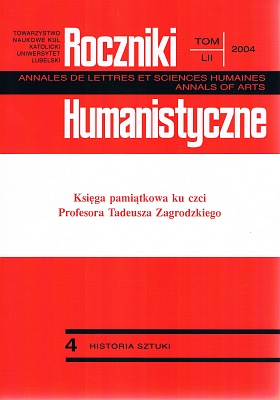Obraz Matki Bożej z kościoła pod wezwaniem Wniebowzięcia Najświętszej Maryi Panny w Łodzi
Abstrakt
Not everybody realizes that besides architectural monuments built in the previous century Łódź also owns a wonderful example of modern painting. Hidden in the neo-Gothic church dedicated to the Assumption of the Holy Virgin Mary the picture of Our Lady is one of the oldest artistic works in the town. In its long history the painting was given various titles: starting from the Dolorous or Glorious, through the Immaculate, Assumed, Merciful, to even being taken by some people for a copy of the picture of Our Lady of Ostra Brama. However, it is most often referred to as Our Lady of Bałuty, or just Our Lady of Łódź.
In the work the history of the church and of the painting were followed, with paying special attention to separating legends from facts. Attempts were made to prove that the opinion about the painting in the Łódź church being a copy of the picture from Ostra Brama is unjustified; it is only the same iconographic type.
It represents painting that is relatively rarely encountered in art. The bust of Mary without the Infant, with her hands crossed on the breast, expresses several truths about the Virgin. It is a sort of synthesis of three iconographic motifs: the Immaculate Conception, the Annunciation and the Assumption.
The way to announcing the dogmas of the Immaculate Conception and the Assumption was especially turbulent and the process lasted from the beginnings of Christianity. Undoubtedly these truths are linked with each other. By the Assumption we also worship Mary's Immaculate Conception. Artists created paintings and sculptures presenting mariological truths. However, the iconography of these dogmas was similar, or even identical. This resulted from the very fact that they co-existed, as well as from their relatively late announcement by the Pope. The picture of the Immaculate Virgin was often changed and the moment of the Assumption was emphasized.
The element that connected these two dogmas was the scene of the Annunciation, in which Mary's fiat united the Immaculate Conception, the virginal maternity and the divine Assumption of God's Mother. This is why the way of presenting Mary in the scene of the Annunciation is analogical to the pictures of the Immaculate Conception or the Assumption, in which Mary's gesture is significant: it is touching the heart or joining her hands in prayer. It is also important that Mary is presented without the Infant, owing to which the painting joins the group of scenes in which the artists had to show a composition of God's Mother without Jesus, but in spiritual communion with God the Father.
The painting of God's Mother in the church dedicated to the Assumption of the Holy Virgin Mary in Łódź closely connects the Immaculate Conception to the Assumption, and also, owing to the specific position of the hands – to the Annunciation. The very fact that in Łódź since 1364 there has been a parish with such a dedication as well as the connection between these dogmas had effect on formation of such an image of God's Mother.
Probably this iconographic type is derived from the Netherlandish graphic arts of the 16th century, that gradually passed to Eastern Europe. This is the way that the model could have reached Poland.
The picture of God's Mother in Łódź is not a copy of the painting from Ostra Brama. They both represent a similar iconographic type, and what follows from it, they are presented in a similar arrangement. However, there are too many elements that are different to say it is a copy.
It is not known who was the painter and from what school he came. He undoubtedly knew the works of Netherlandish and Italian masters, which is proven by the way Madonna was painted.
There are no documents speaking about conservation of the painting, which makes it impossible to date the work precisely. It is possible that it was founded by Paweł Łódź Kubowicz in 1639, as in 1718 it was already considered miraculous.
Copyright (c) 2004 Roczniki Humanistyczne

Utwór dostępny jest na licencji Creative Commons Uznanie autorstwa – Użycie niekomercyjne – Bez utworów zależnych 4.0 Międzynarodowe.





